
Swaddles and sleep sacks are common items used by parents to provide a safe and comfortable sleeping environment for their babies. Both of them aim to keep little ones cozy while reducing the risk of suffocation or other sleep hazards. However, there are notable differences between the two, which can make it tricky for parents to decide which option is best for their baby.
Swaddles are designed to restrict a baby’s movement by wrapping them snugly in a comfortable blanket, mimicking the secure feeling of being in the womb. This can be particularly helpful for newborns and young infants as it soothes them and prevents startle reflexes from waking them up. On the other hand, sleep sacks are wearable blankets that zip up the front, usually keeping the baby’s arms free while still covering the body for warmth and protection.
Key Takeaways
- Swaddles and sleep sacks serve different purposes, with swaddles restricting movement and sleep sacks offering wearable blankets.
- Choosing between a swaddle and a sleep sack depends on factors such as the baby’s age, personal preferences, and designs/features.
- Safely using these products is essential to ensure a healthy sleep environment for the baby.
Understanding Swaddles and Sleep Sacks
Swaddles and sleep sacks cater to the comfort and security of babies during sleep. They share similar goals but have distinct designs and purposes.
Swaddles are small, lightweight blankets that fasten around a baby when they lay down to sleep. Swaddling helps babies feel secure, as the snug wrapping resembles the comfort of the womb. Another advantage of swaddling is its ability to prevent the Moro reflex (the startle reflex), which can cause babies’ arms to flail upwards and disturb their sleep. Some swaddles have features like snaps, zippers, or Velcro to make the process easier and ensure the swaddle stays in place.
Sleep sacks, on the other hand, are like mini wearable sleeping bags for babies and toddlers. Unlike swaddles, sleep sacks do not restrict the movement of arms and legs. They are designed to keep babies warm and comfortable without the need for loose blankets in the crib, thus reducing the risk of suffocation. Sleep sacks come in various sizes, designs, and materials suitable for different ages and seasons.
In summary, both swaddles and sleep sacks serve as alternatives to traditional baby blankets:
- Swaddles are wrap-style blankets targeting newborns and young infants, offering a snug and secure feeling that helps prevent startle reflexes.
- Sleep sacks are wearable blankets that keep babies and toddlers warm and comfortable without restricting movement, making them a safer option for the crib.
Each family’s preference may vary, depending on their baby’s age, comfort needs, and sleep environment. The most important factor is ensuring your little one stays safe and cozy throughout the night.
Importance of Safe Sleep
Ensuring the safety of your newborn or infant while they sleep is crucial in order to prevent risks such as sudden infant death syndrome (SIDS) and suffocation hazards. Following safe sleep recommendations provided by organizations like the American Academy of Pediatrics helps reduce the risk of sleep-related infant deaths.
Safe Sleep Recommendations
The American Academy of Pediatrics provides the following guidelines for safe sleep:
- Place your baby on their back for every sleep, both during the night and for naps.
- Use a firm, flat sleep surface without soft bedding or loose blankets. A properly fitted mattress in a safety-approved crib, bassinet, or play yard is ideal.
- Keep your baby’s sleep area clear of toys, pillows, and crib bumpers, as these can increase the risk of suffocation and entrapment.
- Avoid bed-sharing, as this increases the risk of SIDS, suffocation, or strangulation.
- Consider using a swaddle or sleep sack in place of loose blankets to help keep your baby warm and secure without posing suffocation hazards.
Potential Hazards
Unsafe sleep environments can contribute to an increased risk of SIDS, suffocation, and other sleep-related dangers. Some potential hazards to be aware of include:
- Loose blankets and bedding: They can cover a baby’s face, increasing the risk of suffocation.
- Soft surfaces: Cushioned mattresses, waterbeds, and sofas can create an unsafe sleep environment and increase suffocation hazards.
- Bed-sharing: Sharing a bed with an infant can lead to accidental suffocation or entrapment.
Creating a safe sleep environment and following the recommended guidelines can help protect your newborn or infant from these potential hazards and ensure they sleep safely and soundly.
Choosing Between Swaddle and Sleep Sack
Suitability for Newborns
Swaddling is a popular option for newborns as it recreates the feeling of being in the womb, which can help soothe and calm them down. By tightly wrapping the baby’s arms and torso in a light blanket, swaddling can help to prevent the startle (Moro) reflex in infants, promoting better sleep by making them feel secure and comforted. Many parents swear by swaddling for helping their babies sleep better in the first few weeks of life.
On the other hand, sleep sacks are essentially wearable blankets designed to keep an infant safe, warm, and comfortable. Unlike swaddling, sleep sacks won’t restrict your baby’s arm mobility. They are suitable for newborns through toddlerhood, but they do not provide the same snugness or containment that swaddling does.
Factors for Transition
Transitioning from a swaddle to a sleep sack can be determined based on a variety of factors:
- Age: As your baby grows and develops, it becomes time to transition from swaddling to a sleep sack. By the time your baby is about two months old, it’s a good idea to start considering the switch, as they may begin rolling over soon.
- Mobility: When your baby starts showing signs of rolling over or increased movement during sleep, transitioning to a sleep sack is crucial, as a swaddle might restrict their mobility and safety.
- Sleep patterns: Observe your baby’s sleep patterns closely. Some babies may not rely on the swaddle as much and may easily adjust to a sleep sack, while others might still need the swaddle to sleep better at night.
To make the switch, parents can consider using a transitional swaddle that allows for more mobility in the arms. This way, the baby gets accustomed to the feeling of more freedom while still being partially swaddled.
Overall, the decision to use a swaddle or a sleep sack depends on your baby’s needs and preferences. It’s essential to observe your baby’s sleep habits and respond accordingly. Ensuring their safety and comfort should always be a priority for parents when selecting sleepwear options.
Understanding Different Features
When choosing between a swaddle and a sleep sack for your baby, it’s important to consider the unique features each option offers. In this section, we’ll explore some of these features in more detail.
Zippers, Velcro, and Snaps
Swaddle blankets and sleep sacks come with different closure mechanisms to make securing your baby in their sleep space easier and more efficient. Swaddle blankets typically rely on the caregiver’s swaddling technique and may include Velcro or snaps to help keep the blanket in place. On the other hand, sleep sacks generally have zippers for ease of use and to prevent the sleep sack from coming undone during sleep.
- Swaddle blankets with Velcro or snaps offer the advantage of a more secure, adjustable fit but may require more practice and skill to wrap your baby correctly.
- Sleep sacks with zippers make for a quick and easy way to transition your baby in and out of the sleep sack, especially during middle-of-the-night diaper changes.
Tog Ratings
Another important factor to consider when choosing between a swaddle and a sleep sack is the tog rating. Tog ratings measure the warmth of a fabric. A higher tog rating indicates a warmer fabric suitable for colder room temperatures, while a lower tog rating indicates a lighter fabric for warmer room temperatures. It is essential to consider your baby’s comfort and the room’s temperature when choosing between a swaddle and a sleep sack with different tog ratings.
- Swaddle blankets usually have a lower tog rating and are made of lightweight materials, making them ideal for newborns and younger infants who need a snug, secure sleep space.
- Sleep sacks come in various tog ratings, allowing you to choose one that is suitable for your baby’s age, size, and room temperature. Since sleep sacks are designed for a more extended age range, from newborns through toddlerhood, they provide versatility in tog ratings for different seasons and temperature fluctuations.
By understanding the specific features of swaddle blankets and sleep sacks, such as zippers, Velcro, snaps, and tog ratings, you can make an informed decision on what will work best for your child’s sleep needs. Keep the room temperature, your baby’s age and size, and your personal preferences in mind when selecting a sleep space solution for your little one.
Specific Product Reviews
Kyte Baby Review
Kyte Baby offers a range of sleep solutions for babies, including swaddle blankets and sleep sacks. Their swaddle blankets are made from soft, breathable bamboo fabric, making them perfect for creating a secure and cozy environment for a newborn. The stretchy material allows for easy swaddling without being overly restrictive.
Kyte Baby also offers sleep sacks designed for babies who have outgrown the swaddling stage or prefer more freedom of movement during sleep. These wearable blankets are available in various sizes and materials, ensuring a perfect fit as your baby grows. The sleep sacks feature a zippered front and armholes, allowing for easy diaper changes and temperature regulation.
Snoo Smart Sleeper Review
The Snoo Smart Sleeper is a unique sleep solution incorporating both swaddle elements and sleep sack functionality. Designed as a baby bassinet, the Snoo uses a patented swaddle sack that securely attaches to the bassinet, keeping your baby safely positioned on their back during sleep.
The Snoo swaddle sack is made of a breathable mesh material and offers three size options to accommodate your baby’s growth. It also features a weighted swaddle wrap that gently surrounds the baby, offering a comforting sense of security.
One of the standout features of the Snoo Smart Sleeper is its technological capabilities. The bassinet is equipped with sensors that detect when your baby is crying or experiencing discomfort and responds by providing gentle rocking motion and white noise to soothe them back to sleep.
Both Kyte Baby and Snoo products can be valuable additions to a baby registry, catering to parents’ preferences for traditional swaddle blankets, wearable blankets, or more advanced sleep solutions.
Why Use a Sleep Sack or Swaddle
Swaddles and sleep sacks serve different purposes in helping babies feel secure and comfortable while sleeping. Swaddles are small, lightweight blankets fastened snuggly around a baby to mimic the feeling of being in the womb. This secure wrap helps prevent the Moro reflex, also known as the startle reflex, which causes babies’ arms to flail and can disturb their sleep.
Sleep sacks, on the other hand, are cozy bodysuits made of blanket-like material. They have an opening for the baby’s head and two holes for their arms. These wearable blankets are designed to keep babies warm and prevent the risk of loose blankets covering their faces.
While both swaddles and sleep sacks contribute to a baby’s comfort, they also play a role in promoting safe sleep practices. Since babies should not sleep with loose blankets in their crib, sleep sacks offer an alternative, ensuring they stay warm throughout the night without potential hazards.
Swaddles are best suited for newborns as they provide a sense of security similar to being in the womb. Using a swaddle can get babies accustomed to sleeping in their crib and prevent them from rolling onto their side or stomach, positions not recommended for safe sleep.
As babies grow and outgrow the swaddle stage, they will begin to move more in their sleep, and that’s when sleep sacks come in handy.
Sleep sacks allow for more movement while still providing the warmth and safety of a blanket. In cases where babies still need the comforting snugness of swaddling but require more freedom of movement, weighted swaddles can be another option to explore.
When it comes to nighttime feedings, both swaddles and sleep sacks can easily be incorporated into the routine. Parents have the freedom to choose between giving bottles with the baby swaddled or in a sleep sack, depending on their preference and the baby’s level of comfort.
Overall, the decision to use a sleep sack or swaddle depends on the baby’s age, level of development, and personal preference. Both options provide a cozy, secure environment that promotes better sleep for the baby and peace of mind for the parents.
Frequently Asked Questions
What is the best choice for a newborn, swaddle, or sleep sack?
Newborn babies have a strong startle reflex, which may cause them to feel insecure and disrupt their sleep. Swaddling helps mimic the feeling of being in the womb, comforting the baby and promoting better sleep.
Therefore, a swaddle is often the best choice during the initial weeks of a baby’s life. On the other hand, sleep sacks allow more movement of the baby’s arms and legs, making them a better option as the baby grows and gains more mobility.
When is it safe to transition from swaddle to sleep sack?
It’s generally safe to transition from a swaddle to a sleep sack when the baby starts to show signs of rolling over or has outgrown the swaddle. This typically occurs around 3-4 months of age. Transitioning to a sleep sack at this time ensures the baby’s arms and legs remain free to move, reducing the risk of suffocation and entrapment.
How many sleep sacks and swaddles do I need for my baby?
The number of sleep sacks and swaddles needed for your baby can vary based on factors such as laundry frequency and temperature variations in your home. It’s advisable to have a minimum of 2-3 sleep sacks and swaddles on hand to ensure you have a clean, dry one available while the others are being washed.
Is a sleep sack a safe option when a baby starts rolling over?
Yes, a sleep sack is a safe option when a baby starts rolling over. Sleep sacks are designed to provide warmth without loose blankets and allow the baby’s arms and legs to move freely. This freedom of movement is essential for a baby’s safety when they begin to roll, ensuring they can reposition themselves if needed.
Why has swaddling become less popular in recent times?
Swaddling has become less popular in recent times due to increased awareness and concerns about the potential risks associated with it. These risks include overheating, poor hip development, and respiratory issues. As a result, many parents and caregivers are opting for alternatives like sleep sacks, which offer similar benefits without the potential hazards.
What are the main differences between a sleep suit and a sleep sack?
A sleep sack is essentially a wearable blanket that keeps the baby warm and secure without the need for loose blankets. Sleep sacks usually have a zipper or snaps, making them easy to put on and take off. A sleepsuit, on the other hand, is more like a pair of pajamas without legs. Sleepsuits may have separate openings for each leg or a single opening for both legs, with the primary goal being to keep the baby warm while allowing easy diaper changes.



